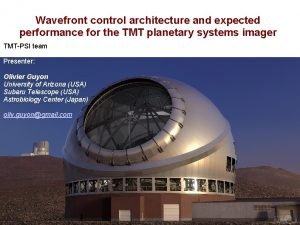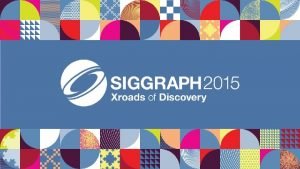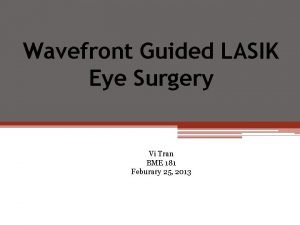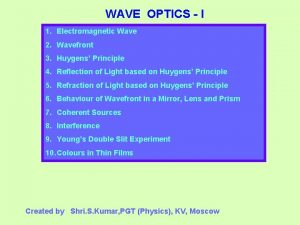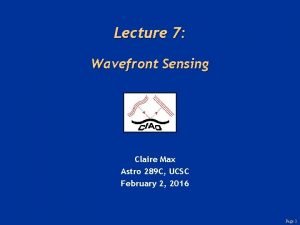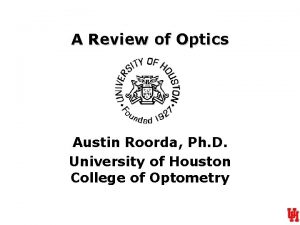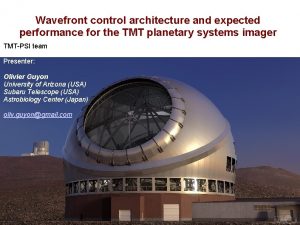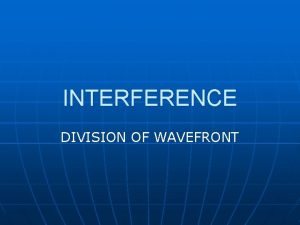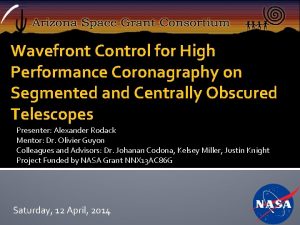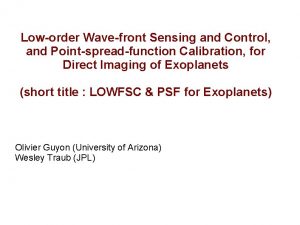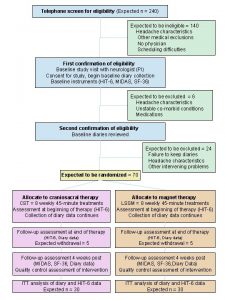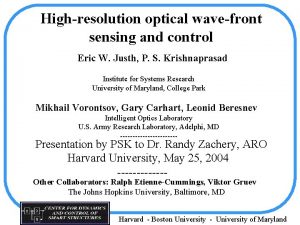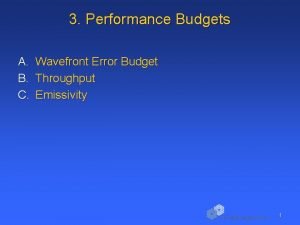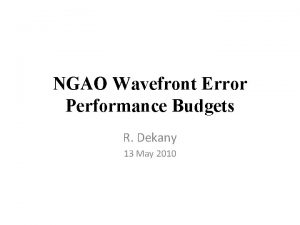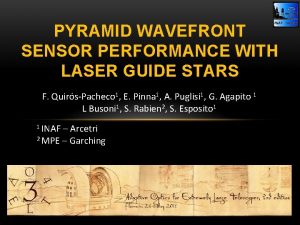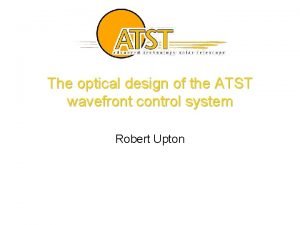Wavefront control architecture and expected performance for the



































- Slides: 35

Wavefront control architecture and expected performance for the TMT planetary systems imager TMT-PSI team Presenter: Olivier Guyon University of Arizona (USA) Subaru Telescope (USA) Astrobiology Center (Japan) oliv. guyon@gmail. com

Science Goals & Instrument Capabilities Broad science reach, enabled by unprecedented angular resolution and sensitivity Exoplanets and Disks (Core Science) Planetary systems architectures Exoplanets characteristics – Bulk properties, Atmosphere compositions Exoplanet Habitabilitiy (search for biomarkers and habitable environments) Disks: Morphology (planet/disk interaction), dust properties Solar system Volcanic eruptions on Io Organics in Comets Asteroid multiples Planetary Atmospheres Galactic Astronomy Stellar multiplicity Stellar evolution Inner Regions of Circumstellar Disks Ice Lines in Disks Dust streamers in Interacting Binaries Compact Objects Extragalactic Astronomy QSOs / AGNs Core Science drives instrument design → Broad wavelength coverage → Spectroscopy → Polarimetry → High Contrast Imaging

Science Goals & Instrument Capabilities Broad science reach, enabled by unprecedented angular resolution and sensitivity Exoplanets and Disks (Core Science) Planetary systems architectures Exoplanets characteristics – Bulk properties, Atmosphere compositions Exoplanet Habitabilitiy (search for biomarkers and habitable environments) Disks: Morphology (planet/disk interaction), dust properties Solar system Volcanic eruptions on Io Organics in Comets Asteroid multiples Planetary Atmospheres Galactic Astronomy Stellar multiplicity Stellar evolution Inner Regions of Circumstellar Disks Ice Lines in Disks Dust streamers in Interacting Binaries Compact Objects Extragalactic Astronomy QSOs / AGNs High Contrast Habitable Planets Imaging and Characterization at near-IR/optical This is the most challenging science goal: drives most WFS/C performance requirements Focus of THIS presentation (everything else is easier)

Instrument Architecture (notional) Wide wavelength coverage 3 science outputs for cameras/spectrographs: - Thermal IR (> 8 um) could be feeding MICHI - Near-IR (2 -5 um) Warm - Optical (< 1. 8 um) Cold

Instrument Architecture (notional) PSI-Blue provides Ex. AO & high contrast Its most challenging science goal is to image and characterize habitable planets Warm optics, deployed at first light and upgradeable: coronagraph masks, control algorithms, back-end instrumentation modules 2+ um science does not critically rely on extreme AO/HCI performance (background-limited) Common DM feeds all ports Cryogenic coronagraph and relay optics. Notionally deployed as facility-class instrument at first light

Wavefront control architecture for Ex. AO Two-stage correction: Common DM (~120 x 120 large stroke) → fast MEMs (~60 x 60 or larger) Dual near-IR and visible WFS provides : (1) Correction on a broad range of targets (2) High Ex. AO performance: - Sensitivity: using both vis and near. IR - Robustness: near. IR WFS for coarse correction, visible for high precision Ex. AO instrumentation is integral part of HCI WFS/C Speckle control: Post-coronagraphic image feeds control loop Low-Order WFS/C: Light discarded by coronagraph encodes low-order aberrations

Contrast and Angular separation Hypothetical Earth-like planets 1 λ/D λ=1600 nm D = 30 m 1 λ/D λ=1600 nm D = 8 m 1 λ/D λ=10000 nm D = 30 m K-type and nearest G-type stars are more challenging, but could be accessible if raw contrast can be pushed to ~1 e-7 (speculative) M-type stars log 10 contrast Around about 50 stars (M type), rocky planets in habitable zone could be imaged and their spectra acquired [ assumes 1 e-8 contrast limit, 1 l/D IWA ] Thermal emission from habitable planets around nearby A, F, G type stars is detectable with GSMTs K-type stars Space-based observatories observing in visible and near-IR light G-type stars 1 Re rocky planets in HZ for stars within 30 pc (6041 stars) F-type stars Angular separation (log 10 arcsec)

Contrast / Separation requirements PSI’s ultimate goal: habitable planet observations around nearby M-type stars: Separation ~2 l/D, ~1 e-8 contrast, m. R~10 Small IWA coronagraphy Ex. AO + Differential imaging Efficient WFS, multi-band, multi-sensor, predictive control

TMT coronagraph design for 1 l/D IWA Pupil Plane PIAACMC lens 2 front surface (Ca. F 2) PIAACMC lens 1 front surface (Ca. F 2) PSF at 1600 nm 3 e-9 contrast in 1. 2 to 8 l/D 80% off-axis throughput 1. 2 l/D IWA Ca. F 2 lenses Si. O 2 mask

Small-IWA coronagraphs already in operation on-sky PIAACMC measured IWA = 1. 43 l/D Vortex measured IWA = 1. 57 l/D MPIAA + Vortex measured IWA = 0. 91 l/D MPIAA + 8 QPM measured IWA = 1. 70 l/D SCEx. AO: new high-performance coronagraphs ready for science Paper 10706 -207, Time: 6: 00 PM - 8: 00 PM, Julien Lozi,

Keck/NIRC 2 vortex gallery 1 λ/D Mawet et al. 2017 Reggiani et al. 2018 Wertz et al. 2016 2 λ/D Serabyn et al. 2017 Slide courtesy of Dimitri Mawet

Differential Detection Techniques Angular Differential Imaging (ADI) Does not address noise limit from slow speckles Spectral Differential Imaging (SDI) (low spectral resolution) Limited by chromaticity in speckles High Resolution Spectroscopy (Snellen et al. , Mawet et al. ) Very clean signal (narrow lines) not present in starlight But few % of planet light used → photon noise (from starlight) limits use Great for giant planets. Challenging for Habitable planets. (See Wang et al. 2017) Polarization Differential Imaging Polarized light fraction is small (<10% ? ) → photon noise (from starlight) limits use Coherent Differential Imaging Can use 100% of light Challenging to implement, calibration issues

High Dispersion Coronagraphy Snellen et al. 2015; Mawet et al. 2017; Wang et al. 2017 See Ji Wang’s talk 10703 -64 on Thursday pm … another slide stolen from Dimitri

Coherent Speckle Differential Imaging

Key WFS/C questions Q 1: What is the optimal detection band for reflected light imaging of habitable planets ? Q 2: What raw contrast is required ? Q 3: What is the optimal wavefront sensing wavelength ? Q 4: How to achieve the raw contrast: Challenges and solutions ?

Q 1: What is the optimal detection band for reflected light imaging of habitable planets ? Scientific Value Blue/visible: Rayleigh scattering 760 nm Oxygen A band H. Rauer et al. : Potential Biosignatures in super-Earth Atmospheres. Astronomy & Astrophysics, February 16, 2011 Near. IR rich in absorption bands: Oxygen (1. 27 um), Water, Methane, Carbon Dioxyde Thermal emission starts at ~3 um, rich in molecules Expected Instrument Capabilities Let us assume that : (1) Ex. AO system can deliver 1 e-6 raw contrast at 1 um (2) Every star has one Earth analog (3) Photon noise limit from both starlight and planet light Initial guess for Q 2 We can scale contrast according to wavelength (C ~ lambda^-2). . and scale coronagraph according to wavelength (IWA ~ lambda) We count, for each spectral band (V, I, J, H, K), how many planets are characterizable: R=40 spectra at SNR=10 can be acquired in < 1 hr (approximate requirement for spectroscopic detection of key molecular species)

V band Too much starlight left → 0 planet characterizable

I band: 24 planets H band: 38 planets J band: 48 planets K band: 28 planets Optimal wavelength range: J & H / Required raw contrast ~1 e-5 / Best targets are M 0 -M 6

Q 3: What is the optimal wavefront sensing wavelength ? Blue light: Better information content per photon, but fewer photons Red light: More photons, but less signal per photon Prime wavelength range: 600 nm to 900 nm

Q 4: How to get ~1 e-5 to 1 e-6 raw contrast in near. IR ? Approach: We first establish contrast error budget for Ex. AO system on a 30 m telescope We assume a “conventional” Ex. AO system, visible SHWFS / near. IR science camera → Identify dominant error terms and explore solutions

D=8 m telescope High contrast imaging at 1. 6 um Wavefront sensing at 0. 8 um 30% efficiency WFS 40% wide WFS spectral band 1 k. Hz WFS frame rate Integrator controller with optimal gain setting Wind speed = 8 m/s Fried parameter r_0 = 0. 15 m at 0. 5 um m_I = 8 target SHWFS 15 cm subapertures Zenith angle = 40 deg Aliasing and readout noise ignored Contrast Error Budget (Primary WFC only)

CHALLENGE #1: WFS sensitivity and time lag

CHALLENGE #2: Chromaticity effects

CHALLENGE #3: Scintillation

Solutions #1: WFS sensitivity and time lag → PSI uses diffraction-limited WFS approaches, >1000 x more sensitive than SHWFS Instrument architecture ensures that Pyramid WFS operates in diffraction-limited regime → PSI uses both visible and near. IR light for WFS for optimal sensitivity → PSI uses predictive control to replace time lag with (much smaller) prediction error #2: WFS chromaticity → PSI uses near-IR WFS (pupil plane) and speckle control at/near science wavelength #3: Scintillation → PSI uses focal plane speckle control to sense and correct scintillation speckles

Wavefront control architecture for Ex. AO Two-stage correction: Common DM (~120 x 120 large stroke) → fast MEMs (~60 x 60 or larger) Dual near-IR and visible WFS provides : (1) Correction on a broad range of targets (2) High Ex. AO performance: - Sensitivity: using both vis and near. IR - Robustness: near. IR WFS for coarse correction, visible for high precision Ex. AO instrumentation is integral part of HCI WFS/C Speckle control: Post-coronagraphic image feeds control loop Low-Order WFS/C: Light discarded by coronagraph encodes low-order aberrations

Advanced Ex. AO requires Advanced Control Algorithms: Predictive Control and Sensor Fusion Conventional AO: Measure RM/CM Advanced AO control: Use past measurements (predictive control) and other measurements (sensor fusion) → control matrix is very big, and usually impossible to measure Derive CM from WFS(s) telemetry The compute and control for adaptive optics (CACAO) real-time control software package Olivier Guyon et al. 13 June 2018 • 11: 40 AM - 12: 00 PM

First on-sky results (2 k. Hz, 50 sec update) → 2. 5 x raw contrast improvement OFF (integrator, gain=0. 2) ON Average of 54 consecutives 0. 5 s images (26 sec exposure), 3 mn apart Same star, same exposure time, same intensity scale

TMT PSI development, prototyping In addition to lab activities, new on-sky instruments will be validating TMT-PSI subsystems: SCEx. AO @ Subaru - System-level prototype for PSI-blue, with similar overall architecture - Multiple Coronagraphs - Many WFSs, Camera, Modules → system-level testing of WFS/C algorithms - Focal Plane Speckle Control with MKIDs + other cameras KPIC @ Keck - Integrates small-IWA coronagraphy, HDC and near-IR Py. WFS - Prototype for PSI-red (2 -5 um) Mag. AO-X @ Magellan - Follows similar architecture as SCEx. AO - Focus on short wavelength → validation/evaluation of PSI-blue solutions Possible SPHERE and GPI upgrades - Pyramid WFS, focal plane WFS, advance AO control


~0. 5 Hz ~2 k. Hz CORONAGRAPHIC LOW ORDER LOOP Extreme-AO LOOP 10 -200 Hz High speed pyramid wavefront sensor Measures aberrations 14, 400 sensors (pix) Near-IR camera Measures low-order aberrations 800 – 2500 nm (rejected by coronagraph) 3. 5 k. Hz <800 nm MKIDs camera coronagraph 800 – 1350 nm system Measures residual starlight removes starlight Facility Adaptive Optics system 2000 actuator Deformable mirror >800 nm SPECKLE CONTROL LOOP Sharpens image CHARIS spectrograph Visible light instruments VAMPIRES, FIRST, RHEA Near-IR instruments Nuller, Hi. CIAO, IRD Exoplanet spectra Slow speckle calibration

Modules The wavefront control feeds a high Strehl PSF to various modules, from 600 nm to K band. Visible (600 – 950 nm): VAMPIRES, non-redundant masking, polarimetry, with spectral differential imaging capability (h-alpha, SII) FIRST, non-redundant remapping interferometer, with spectroscopic analysis RHEA, single mode fiber injection, high-res spectroscopy, highspatial resolution on resolved stars IR (950 -2400 nm): Hi. CIAO - high contrast image (y to K-band) SAPHIRA - high-speed photon counting imager, (H-band for now) CHARIS - IFS (J to K-band) MEC - MKIDs detector, high-speed, energy discriminating photon counting imager (y to J-band) NIR single mode injection, high throughput high resolution spectroscopy. Soon will be connected to the new IRD Various small IWA (1 -3 l/D) coronagraphs for high contrast imaging – PIAA, vector vortex, 8 OPM GLINT - NIR nulling interferometer based on photonics Jovanovic et al, PASP, 127, 890 (2015)

Keck Planet Imager and Characterizer Keck II AO Xinetics 359 -actuator DM 20 x 20 SH-WFS IR Pyramid WFS Leonardo/SAPHIRA e-APD Fiber Injection Unit BMC kilo-DM Vortex coronagraph CRED 2 LVF-Fiber. Guide NIRC 2 High-Res Imager, L/M vortex coronagraph Aladdin 3 In. Sb 0. 95 -5 μm R=100 -1, 000 Giant Planet Imaging Fiber Extraction Unit NIRSPEC High-Res Spec Hawaii 2 RG 0. 95 -5 μm R=38, 000

Near. IR Pyramid WFS @ KPIC See Charlotte Bond’s invited talk 10703 -72, Thursday pm

Next steps, outstanding WFS/C questions Source faint-ness remains a significant challenge → Operating Py. WFS at its full efficiency needs to be demonstrated → Full benefits of predictive control needs to be quantified Multi-DM multi-sensor AO operation is challenging → How to optimally combine signals → Need to develop real-time algorithm, machine learning Differential detection techniques need to be developed and validated → HDC validation → CDI validation High speed focal plane WFS/C is relatively immature → Algorithm development → On-sky validation → Hardware: MKIDs, SAPHIRA, EMCCD See: The planetary systems imager: a high-contrast instrumentation platform for the Thirty Meter telescope Paper 10702 -74 Time: 5: 00 PM - 5: 20 PM Michael P. Fitzgerald + PSI team
 Wavefront architecture
Wavefront architecture Wavefront
Wavefront Wavefront
Wavefront Em wave2
Em wave2 Shack hartmann wavefront sensor tutorial
Shack hartmann wavefront sensor tutorial Plane wavefront
Plane wavefront Cloud gaming architecture and performance
Cloud gaming architecture and performance Iso 22301 utbildning
Iso 22301 utbildning Typiska drag för en novell
Typiska drag för en novell Tack för att ni lyssnade bild
Tack för att ni lyssnade bild Ekologiskt fotavtryck
Ekologiskt fotavtryck Varför kallas perioden 1918-1939 för mellankrigstiden?
Varför kallas perioden 1918-1939 för mellankrigstiden? En lathund för arbete med kontinuitetshantering
En lathund för arbete med kontinuitetshantering Personalliggare bygg undantag
Personalliggare bygg undantag Tidbok för yrkesförare
Tidbok för yrkesförare Anatomi organ reproduksi
Anatomi organ reproduksi Densitet vatten
Densitet vatten Datorkunskap för nybörjare
Datorkunskap för nybörjare Stig kerman
Stig kerman Att skriva debattartikel
Att skriva debattartikel Delegerande ledarskap
Delegerande ledarskap Nyckelkompetenser för livslångt lärande
Nyckelkompetenser för livslångt lärande Påbyggnader för flakfordon
Påbyggnader för flakfordon Tryck formel
Tryck formel Publik sektor
Publik sektor Kyssande vind
Kyssande vind Presentera för publik crossboss
Presentera för publik crossboss Argument för teckenspråk som minoritetsspråk
Argument för teckenspråk som minoritetsspråk Kanaans land
Kanaans land Klassificeringsstruktur för kommunala verksamheter
Klassificeringsstruktur för kommunala verksamheter Mjälthilus
Mjälthilus Bästa kameran för astrofoto
Bästa kameran för astrofoto Cks
Cks Byggprocessen steg för steg
Byggprocessen steg för steg Bra mat för unga idrottare
Bra mat för unga idrottare Verktyg för automatisering av utbetalningar
Verktyg för automatisering av utbetalningar
